
|
| « History of Playing Cards | Early Standards | Gallery of Playing Cards | Card Games | Card Backs |
History of Card Making in France
French Regional Patterns of the 18th Century
The playing of cards has not always been looked upon as innocently as playing canasta with your grandmother. The earliest historical references to playing cards come from objections and prohibitions. It is little wonder, as cards were invariably associated with gambling, and around smoky dens and gaming-houses, the practice of playing cards could not easily have taken on a wholesome reputation.
No small mention that many a young prince or impudent Earl had tried their hand at games of luck and chance, and lost their fortune doing it. It should be no surprise, then that sovereigns throughout the ages have in no pretence restrained themselves from imposing taxes or duties on playing cards.
By the beginning of the Eighteenth century, war, and no doubt extravagance, had drained France's national treasury to little more than copper coins in a tin pot. In 1701 a new duty was imposed on playing cards of 18 deniers a deck. In order to collect the new tax, the country was divided into nine manufacturing regions. Each manufacturer was required to submit a design block to the ‘Recettes generales’. It was in this manner that each region was allotted its own design.
This was not the ushering in of nine entirely new designs, but rather formalized or "registered" what was already there. At this time there was much more lucidity in the way playing cards were interpreted. There was more variation in the objects, weapons and manner of attire for our members of the Royal Household. And therefore, there was much more latitude to improvise and to create.
As you can imagine, after centuries of tradition, once the French got hold of playing cards we had Kings playing harps, Queens with pretty birds on their wrists, and even a Valet admired for his long flowing plume.
In France’s high fashion world of playing cards, submitting a design to the ‘Recettes generales’ did not only have the unfortunate consequence of binding one to the tax office, but it was also a means of registering a pattern, and laying exclusivity to a design. After all, if your Valet of Spades has pretty plaits, and now everybody else’s does, too, you want to be able to say something about that.
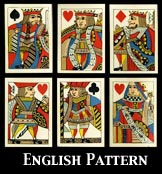
It is a rich and interesting heritage from which the English pattern emerges, and it owes much to the French for their ingenuity in design and style.
The nine regions designated under this tax regime were Paris, Bourgogne, Lyonnais, Auvergne, Daulphiné, Provence, Languedoc, Guyenne and Limousine. These remained in place until the 1790s when the tax was repealed by the States General.
Paris
This region took in the whole of the north of France including the towns of St. Omer, Pas de Calais, Rouen, Brest, Nantes on the west coast, Tours, Troyes and Lille. The cities of Epinal, , Metz and Nancy as well as Strasbourg on the German frontier were added later, in 1751.
The most notable feature of this design is that all the members of the royal household have large bodies. The King of Hearts has an imperial eagle hidden in the folds of his cloak. The King of Clubs is accompanied by a small animal which is said may be a lion. The King of Diamonds has a shell-shaped panel let into his cloak and the King of Spades leans against a harp.
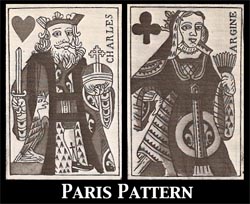
Each of the Queens wears a crown and holds a flower. The Queen Spades, like the King of Diamonds, has a shell-like panel on her cloak. The Queen of Diamonds, from about 1751 on, carries in her left hand a bag embroidered with a ‘thought’.
The Knave of Diamonds is drawn in profile but the Heart in full face. The Knave of Clubs leans on a halberd and the Knave of Spades wears a hat with a feather and is accompanied by a dog.
The playing cards of this region, particularly those of Rouen, were exported all over Europe. They were especially popular in Flanders, but were also well known in Spain, Russia, England, Switzerland, Sweden and Denmark.
Bourgogne
This district lay in the middle of France on the eastern side. The towns included Dijon, Besançon and Salins. This regional pattern was a copy of the one produced at Lyons in the 17th century and exported to Bourgogne, Lorraine, Provence and Flanders.
The chief feature is the splendid plume flowing from the Knave of Clubs’ helmet, from which the deck acquired the name of La Plume à Chapeau.
In this pattern the Kings wear large floral crowns and voluminous robes trimmed with ermine and each, excepting the King of Hearts, holds a sceptre decorated with a fleur-de-lis. The King of Hearts has a kind of ring ornament on his chest.
The Queens, except the Queen of Diamonds, hold flowers and wear large embroidered cloaks. The Knave of Hearts is the only one seen in full face, the rest in profile, and the Knave of Spades has his hair in plaits.
Lyonnais
The Lyonnais design was basically that used by the card masters of Lyons and the surrounding district in the 16th and 17th century.
The four Kings and the Queen of Hearts and the Queen of Spades originally carried floral sceptres. The King of Hearts has a bird on his wrist, the Queen of Hearts a flower, and the Queen of Clubs nothing at all.
The full-faced Knave of Clubs leant on a club while the Knave of Spades wore a kind of visor and was armed with an axe.
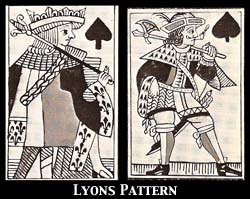
From 1711, the Knave of Spades is given a pipe to smoke. And then in 1751, the King of Clubs was given an Orb. The Queens of Hearts and Spades lose their sceptres and now all four Queens carry flowers. The Knave of Clubs club was replaced with a lance and on his right arm he now has a shield.
Lyons exported to Switzerland as its main revenue from trade.
Auvergne
This district lay in central France and included the towns of Theirs, Clermont, and Le Puy. The design seems to be a replica of one by a well known card master of Theirs in the previous century – Jean Volay.
The Kings of Diamonds, Spades and Clubs carry sceptres while the King of Hearts carries a sword. The King of Clubs has a parrot perched on his left hand.
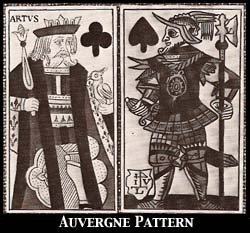
Each Queen holds a sceptre with a flower on the tip. The Queen of Spades has a small dog blanced on her right arm, while the other three Queens each carry a flower.
Each Knave is clothed in armour, armed with a sword and leans on a halberd. The Knave of Hearts has a lyre-shaped badge representing arms, replacing what used to be placed, the Lion of Theirs.
Daulphiné
This district lay in the south east of France and was bordered by the Alps, the Rhone and Provence. The principal towns involved in playing card manufacturing were Grenoble, Romans and Valence.
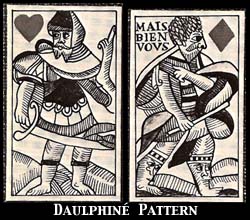
Few examples have been preserved, but from the scant artefacts we do have we can see some interesting variations. For one thing, we know the King of Diamonds has a bird on his wrist. The Knave of Hearts has his sword drawn in his right hand and points upward with his left. And the Knave of Diamonds is bear-headed and wrapped in a cloak.
Provence
Provence lies in the south east corner of France. In the 18th century its main card-producing towns were Aix, Marseilles, Toulon, Avignon, Nimes and Montpellier.
This design was an older one dating from the 15th century and is thought to have evolved from playing cards shipped to Provence from Lyons at an even earlier date.
Most notable, the King of Hearts has a small bird on his wrist. The bird, like the King, wears a crown and has a human face. The King of Clubs is armed with an axe, and the King of Diamonds has an exceptionally thin sceptre. The King of Spades, seen in profile, holds his sceptre over his shoulder.
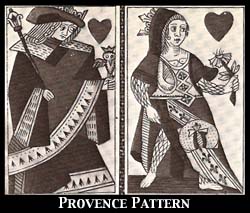
Another distinctive feature is the Queen of Hearts, who wears what seem to be scales, or perhaps fur, under her robe which can also be seen on her arms and legs. She holds her right arm up, and leaning backwards balances on her right left leg. The Queens of Clubs and Spades hold flowers, and the Queen of Diamonds wears a strange ring-like fleur-de-lis trimmed tippet.
The Knaves of Clubs and Spades have plaited hair. The Knave of Hearts is drawn full-faced, right hand on hip and holds a halberd in his left. The Knave of Diamonds wears a jerkin reaching down to his knees.
Languedoc
This region was in the south of France, lying between Garonne and the Rhone. The capital was Toulouse and the regional design was published in that city and also in Carcassone, Beziers, and Albi.
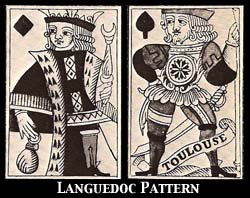
The most notable features are the King of Diamonds carries a purse in his right hand and holds an orb in his left. The King of Hearts wears a breast plate with a large fleur-de-lis on it.
Guyenne
This region occupied the western part of southern France. The principal towns involved in playing-card manufacture were Bordeaux, Montanban and Agen.
The Kings of Hearts carries a very thin sceptre with a large fleur-de-lis at the top. The King of Clubs sceptre has a heart-shaped ornament at the top, and above that is a flaming vase. The King of Diamonds wears a large cloak and holds in his right hand a pointed shield upon which is the Arms of France. In his left hand is a sceptre topped with a heart-shaped ornament. Later, the Arms of France is replace by the monogram of Louis XIV, and later still by a shining sun. The King of Spades is armed with an axe and on his chest is a rose within a circle.
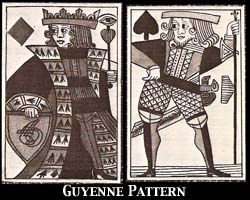
All the Knaves have large sleeves. The Knave of Diamonds has a pointed beard. The Knave of Spades hold his right hand on his hip and a halberd in his left. The Knave of Clubs has plaited hair beneath a flat cap and a flower.
From Bordeaux, many playing cards were shipped to Spain.
Limousine
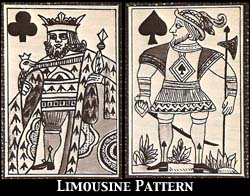
The region of Limousine lay in the middle of France on the western side. Its design, which is regarded as a bad copy of the Auvergne design, was used by the cities of Limoges, Angoulême and Poitiers. Limoges also exported much of her production to Spain.
The 1780s
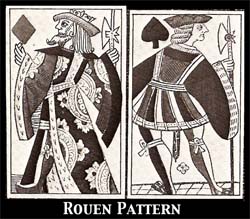
Throughout the 18th Century, French card makers had enjoyed export trade across Europe. The regions of Limoges, Bordeaux and Theirs exported to Spain, Lyons traded with Switzerland, and the Rouen pattern was circulating in as far apart as Sweden, Russia, Denmark, Flanders and England. By the 1780s, many of the regional patterns were fading away, and the Paris pattern rose to pre-eminence as the general pattern throughout France.
Further Reading
Early Standard Playing Cards |
|

|
Very little is known about the history of card making in England. However, through a pictorial history of French, English and American patterns it is clear to see the origins of the English Pattern and its patrimony in the French Rouen design. |
Card Masters of the 19th Century
|
L I N K S
| Rouen Pattern | The English pattern derives for a 15th century design made in Rouen France. Long since abandoned by the French, is undoubtedly the model from which the English pack eveolved. |
| The English Standard |
Annotation of the specific features that define early English court cards. PlainBacks.com is a celebration of the English court card as a cultural design icon. |
| Pierre Marechal (1567) |
A pack of cards made by Pierre Marechal c.1567 preserved in the museum at Rouen. The style of the costumes is late medieval... |
| ||||||||
| ||||||||
| ||||||||
|
||||||||
|